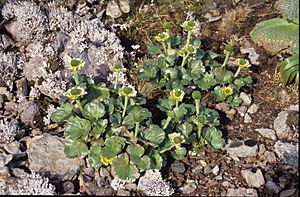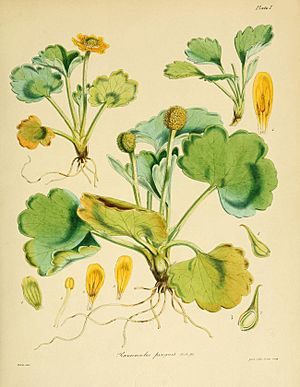Ranunculus pinguis facts for kids
Quick facts for kids Ranunculus pinguis |
|
|---|---|
 |
|
| Ranunculus pinguis | |
| Conservation status | |
|
Invalid status (NZ TCS)
|
|
| Scientific classification | |
| Genus: |
Ranunculus
|
| Species: |
pinguis
|
| Synonyms | |
|
|
Ranunculus pinguis is a special type of buttercup plant. It has dark green, thick leaves and grows in clumps. Its flowers are yellow, quite large, and have short stems. This plant is found only in New Zealand, specifically on the Auckland Islands and Campbell Islands. It blooms (flowers) from December to January and makes seeds between February and April.
Contents
What's in a Name?
The name Ranunculus comes from a Latin word meaning "little frog." This is probably because some buttercup plants grow in wet places, just like frogs. The second part of its name, pinguis, is also Latin. It means "thick" or "fat," which describes its fleshy leaves.
How to Spot It
Plant Features
Ranunculus pinguis is a plant that grows back every year. It can be 5 to 25 centimeters tall. It has a strong underground stem called a rhizome. Its leaves have stalks and are 2 to 8 centimeters long. The leaves can be smooth or a bit hairy. They are shaped like a diamond or a kidney.
Leaves and Flowers
The leaves usually have three to five lobes, or sometimes seven. Their edges often have a few large, rounded teeth. The flowers grow one by one and are 2 to 3 centimeters wide. Their stems are straight and often hairy, especially near the top.
Petals and Seeds
The plant has five to ten yellow petals. These petals are shaped like narrow spoons. Each petal usually has one tiny cup, called a nectary, which holds sweet liquid. After flowering, the plant makes dry, one-seeded fruits. These fruits are called achenes. They are usually smooth but can sometimes be hairy. Each achene is about 1.5 to 2 millimeters long, with a straight beak about 2 millimeters long. This plant has 48 chromosomes.
Where It Lives
Island Homes
Ranunculus pinguis is quite common on Campbell Island. It grows among rocks, from the sea up to the tops of the hills. You often find it in places where sheep cannot reach it.
Growing Conditions
On the Auckland Islands, it also grows among rocks. You can see it in open areas along the hilltops, especially where the soil is moist and stony. It also grows at the higher edges of grasslands, in peaty soil. Plants that grow in sheltered spots have larger, smooth leaves. Plants in open, windy places have smaller leaves.
Plant Family Tree

There are some small differences between the plants on the Auckland and Campbell Islands. For example, plants from Auckland often have rounder, smooth leaves. They also tend to have more and larger petals, often with three nectaries. Plants from Campbell Island often have round or kidney-shaped leaves covered in fine, silky hairs.
Even with these differences, scientists do not separate them into different types. This is because the plants on both islands show a mix of these features. Genetic tests show that R. pinguis is closely related to a group of other buttercups. This group includes R. gunnianus, R. pachyrrhizus, R. sericophyllus, and R. viridis.
Protecting This Plant
In 2009, 2012, and again in 2018, Ranunculus pinguis was listed as "At Risk - Naturally Uncommon" by the New Zealand Threat Classification System. This means it is not very common because it only grows in a small area.

